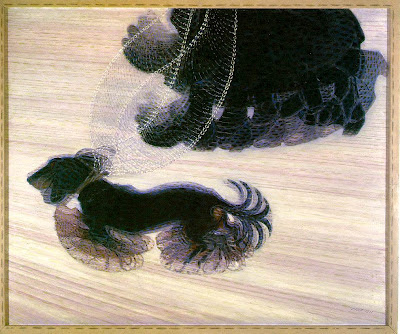In preparation for this week's homework assignment, which appears at the end of this post, here are a few images to refresh your memory about depicting movement in still images (i.e., drawings and paintings). The works below are all by the great Italian Futurist Giacomo Balla.
DEPICTING MOVEMENT IN STILL IMAGES:
This week’s assignment is about further exploring ways of conveying movement in drawings. You may choose either of the following approaches:
(1) Drawing from film: Make a drawing based on a selected sequence in your favorite film. Because you’ll want to watch the sequence a number of times at various speeds, be sure you have the proper equipment (i.e., don’t work from memory).
After selecting a good film sequence that you would like to interpret graphically, begin by making a series of quick studies in your notebook. Just as we did in class, concentrate on the way your line quality (or the quality of your marks) reflects the qualities of the various movements your sequence involves (i.e., quick and frenetic, slow and graceful, jumbled and chaotic, precise and mechanical, etc.). You may want to experiment with various drawing materials and colors before beginning your final drawing.
When you have a good sense of how you want to compose your piece, make a drawing on your regular homework paper. Your final piece can be as abstract as it needs to be, as long as it is an interpretation of the movement you observe in your film sequence.
(2) Flipbook: Make a flipbook that creates an illusion of movement as the viewer flips through its pages. Taking some cues from William Kentridge, a very good approach to this is to begin with a used paperback book (you can buy these on the street for cheap or at used bookstores). Be sure to “test” your book before purchasing it (i.e., make sure it’s the kind of book that allows for easy and fluid flipping.) The idea is to use the existing pages creatively, drawing over and around the text however you see fit.
Your sequence of drawings can be abstract (as in a “dancing” line or shape), representational (as in a leaping ballerina), or any combination of the two. Whatever you choose to do, be sure the sequence is long enough to create a rewarding illusion of movement for the viewer. Please keep in mind that your flip book should be a work of art – i.e, it should be something more than the kind of doodle one does in one's algebra text book!







No comments:
Post a Comment